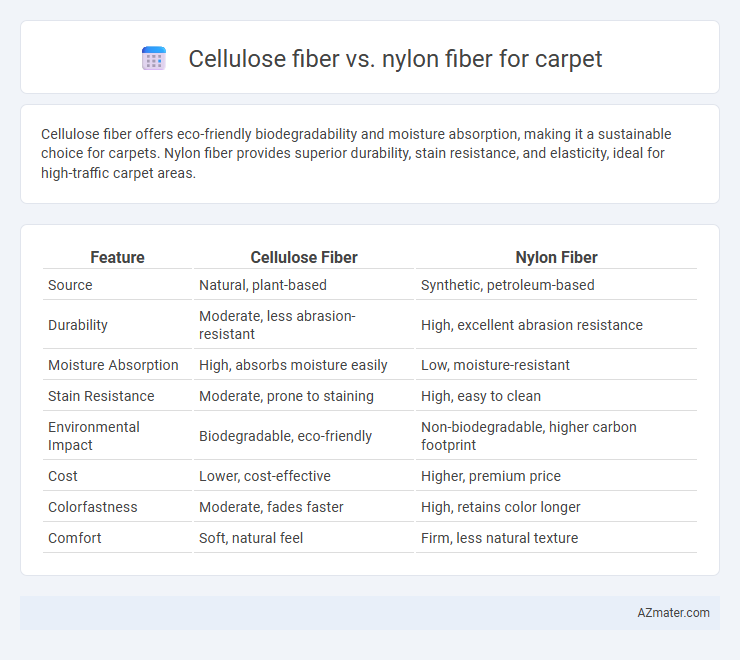Cellulose fiber offers eco-friendly biodegradability and moisture absorption, making it a sustainable choice for carpets. Nylon fiber provides superior durability, stain resistance, and elasticity, ideal for high-traffic carpet areas.
Table of Comparison
| Feature | Cellulose Fiber | Nylon Fiber |
|---|---|---|
| Source | Natural, plant-based | Synthetic, petroleum-based |
| Durability | Moderate, less abrasion-resistant | High, excellent abrasion resistance |
| Moisture Absorption | High, absorbs moisture easily | Low, moisture-resistant |
| Stain Resistance | Moderate, prone to staining | High, easy to clean |
| Environmental Impact | Biodegradable, eco-friendly | Non-biodegradable, higher carbon footprint |
| Cost | Lower, cost-effective | Higher, premium price |
| Colorfastness | Moderate, fades faster | High, retains color longer |
| Comfort | Soft, natural feel | Firm, less natural texture |
Overview of Carpet Fibers: Cellulose vs Nylon
Cellulose fiber, derived from natural materials like cotton and wood pulp, offers biodegradable and eco-friendly properties, making it a sustainable choice for carpets. Nylon fiber, a synthetic polymer, provides exceptional durability, resistance to abrasion, and stain repellency, ideal for high-traffic areas and long-lasting carpet performance. While cellulose fiber carpets excel in environmental impact and softness, nylon fibers dominate in strength, resilience, and ease of maintenance.
Understanding Cellulose Fiber Carpets
Cellulose fiber carpets, primarily made from natural materials like cotton, hemp, or regenerated cellulose (rayon), offer superior moisture absorption and biodegradability compared to synthetic nylon fibers. While nylon fibers exhibit outstanding durability, stain resistance, and elasticity, cellulose fiber carpets provide a softer feel and enhanced environmental sustainability. Understanding the trade-offs between these fibers is crucial for selecting carpets that balance performance, comfort, and ecological impact.
Properties and Benefits of Nylon Fiber Carpets
Nylon fiber carpets offer exceptional durability, stain resistance, and superior abrasion resistance compared to cellulose fiber carpets, making them ideal for high-traffic areas. Their resilience and elasticity contribute to maintaining shape and appearance over time, while their moisture-wicking properties prevent mold and mildew growth. Nylon fiber also provides vibrant color retention and easy maintenance, enhancing carpet longevity and aesthetic appeal.
Durability Comparison: Cellulose Fiber vs Nylon Fiber
Nylon fiber exhibits superior durability compared to cellulose fiber in carpet applications, owing to its high resistance to abrasion, crushing, and wear over time. Cellulose fibers, derived from plant materials, tend to degrade faster under heavy foot traffic and exposure to moisture, leading to reduced longevity. The superior tensile strength and elasticity of nylon fibers contribute to carpets that maintain their appearance and structural integrity longer in commercial and high-traffic residential settings.
Stain Resistance and Maintenance Needs
Cellulose fiber carpets, derived from natural plant materials like wood pulp, offer moderate stain resistance but require frequent cleaning to prevent moisture-related damage and mold growth. Nylon fiber carpets provide superior stain resistance due to their synthetic composition and can be treated with protective coatings, making maintenance easier and less frequent. Nylon's durability and ability to repel common stains make it a preferred choice for high-traffic areas requiring low maintenance.
Environmental Impact: Sustainability and Eco-friendliness
Cellulose fiber, derived from renewable natural sources like wood pulp, offers enhanced sustainability and biodegradability compared to petroleum-based nylon fiber, which contributes to greenhouse gas emissions and microplastic pollution. Cellulose carpets reduce landfill waste due to their compostable nature, while nylon carpets require energy-intensive recycling processes often resulting in downcycling. The eco-friendliness of cellulose fiber supports low carbon footprints and reduced reliance on fossil fuels, positioning it as a greener alternative for environmentally conscious carpet manufacturing.
Comfort and Aesthetic Differences
Cellulose fibers, such as those derived from natural sources like cotton or bamboo, offer superior breathability and softness, enhancing carpet comfort with a natural, matte appearance that resists static buildup. Nylon fibers provide exceptional durability and resilience, maintaining vibrant colors and a lustrous finish that complements modern aesthetics while offering superior stain resistance. Choosing between cellulose and nylon fibers depends on preferences for natural texture and comfort versus long-lasting vibrancy and toughness in carpet applications.
Cost Analysis: Initial Investment and Long-term Value
Cellulose fiber carpets generally have a lower initial investment due to the abundance of raw materials like wood pulp and agricultural byproducts, making them cost-effective for budget-conscious buyers. Nylon fiber carpets tend to have a higher upfront cost but offer superior durability and resistance to wear, which translates into lower maintenance expenses and longer replacement cycles. Over time, nylon carpets may provide better long-term value because their enhanced resilience reduces the frequency of repairs and replacements compared to cellulose fiber options.
Best Applications for Cellulose and Nylon Carpets
Cellulose fibers, derived from natural sources like cotton and wood pulp, offer excellent breathability and moisture absorption, making them ideal for residential carpets in low-traffic areas and eco-friendly commercial spaces prioritizing sustainability. Nylon fibers, known for their exceptional durability, resilience, and stain resistance, are best suited for high-traffic commercial carpets, offices, and hospitality environments where long-term performance and easy maintenance are critical. Choosing cellulose fibers enhances indoor air quality and comfort, while nylon carpets provide superior wear resistance and color retention in demanding settings.
Choosing the Right Fiber: Factors to Consider
Cellulose fiber in carpets offers superior moisture absorption and eco-friendly biodegradability, making it ideal for environmentally conscious consumers seeking natural durability. Nylon fiber provides exceptional resilience, stain resistance, and longevity, suited for high-traffic areas requiring durability and easy maintenance. Key factors to consider include durability requirements, moisture exposure, stain resistance needs, and environmental impact to select the most suitable fiber for specific carpet applications.

Infographic: Cellulose fiber vs Nylon fiber for Carpet
 azmater.com
azmater.com